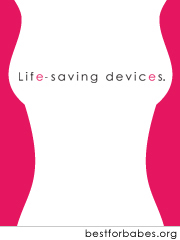Combining hand techniques with electric pumping increases milk production in mothers of pre-term infants J Morton, JY Hall, RJ Wong, L Thairu, WE Benitz, and WD Rhine: Department of Pediatrics, Stanford University School of Medicine, Stanford, CA, USA: Journal of Perinatology (2009) 29 757-764
This study involved 67 mothers of preterm babies of less than 31 weeks gestation and who weighed less than 1500g. It was designed to determine if hand expression of colostrum in the first few days, combined with pumping mature milk using hands-on-pumping techniques (massage and breast compression while pumping) could prevent low milk supply, which is common in pump dependant mothers of pre-term infants. While these infants benefit greatly from receiving breast-milk, their mothers frequently have difficulty maintaining an adequate milk supply.
Mothers were taught hand expression techniques and were encouraged to hand express their colostrum, as many times as possible, for the first three days. Additionally, they were instructed to double pump 8 times every 24 hours, beginning within the first 6 hours postpartum. After their milk came in, mothers were instructed to pump 8 or more times per day until they could express only drops.
Hands-on-pumping (HOP) instruction began at 20.6 +- 9.6 days postpartum. Mothers were instructed to double pump while simultaneously compressing breasts and massaging firmer areas. They were encouraged to watch the results of their massage and compression and adjust their technique to maximize output. When milk flow stopped, mothers were instructed to stop pumping and massage breasts for 1-2 minutes, after which, they used whatever techniques they preferred to finish expressing their milk. Some mothers chose to continue double pumping with HOP, some mothers single pumped each side with HOP and some chose to finish by using hand expression only.
It was determined that moms who hand expressed colostrum more than 5 times per day, in the first three days, not only increased available colostrum but were able to produce a larger supply of mature milk than mothers who expressed colostrum fewer times in the first 3 days. This difference was statistically significant at weeks 1 through 7. Additionally, after HOP training, mothers increased their own mean daily volumes of breast-milk by 48%, as measured during the 3 days preceding HOP training compared to measurements taken at week 8. By the end of the 8 week study, the mean daily volume of milk that the mothers who completed the study, were able to produce, was more than adequate to feed their babies.
Other factors usually associated with milk production, such as type of delivery, maternal BMI, history of previous breastfeeding, multiples and IVF, were not found to apply in this study, suggesting that they may have been mitigated by the techniques taught to these moms.
With hand expression and hands-on-pumping, it may be easier for moms of premature infants to provide all the breast-milk that their infants need, without relying on donor milk and to build and maintain adequate supplies until their babies are able to feed at the breast. The findings in this study may also apply to moms of term infants who pump their milk or who have a low milk supply. Hand expression in the first few days and the use of the HOP technique might help mitigate other variables, in addition to prematurity, that are associated with low supply. It may also help moms who must pump, due to employment or other factors, maintain an adequate milk supply to nourish their infants. Because low milk supply is a common factor for weaning, these techniques may have a large impact on the number of mothers who continue to breastfeed.
The information regarding hand expression of colostrum indicates how important milk removal is in the first few days of lactation. This technique is accessible to every mother regardless of socio-economic status. Hand expression is simple, always available and requires no electricity or expensive equipment. Some mothers in the study were also able to hand express significant amounts of mature milk after removing all they could by hands-on-pumping. This suggests that hand expression of mature milk may have the potential to be as, or more reliable for milk removal, as is using an electric pump.
Here is a link to a video presentation of the techniques used in the study
http://newborns.stanford.edu/Breastfeeding/MaxProduction.html
©2010 Laura Spitzfaden LLLL IBCLC Feed the Baby LLC



